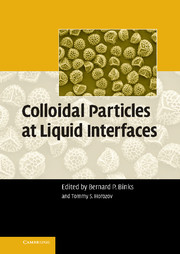Book contents
- Frontmatter
- Contents
- Preface
- List of Contributors
- 1 Colloidal Particles at Liquid Interfaces: An Introduction
- Section 1 Particles at Planar Liquid Interfaces
- 2 Structure and Formation of Particle Monolayers at Liquid Interfaces
- 3 Theory for Interactions between Particles in Monolayers
- 4 Particle-Assisted Wetting
- Section 2 Particles at Curved Liquid Interfaces
- Index
2 - Structure and Formation of Particle Monolayers at Liquid Interfaces
Published online by Cambridge University Press: 11 October 2009
- Frontmatter
- Contents
- Preface
- List of Contributors
- 1 Colloidal Particles at Liquid Interfaces: An Introduction
- Section 1 Particles at Planar Liquid Interfaces
- 2 Structure and Formation of Particle Monolayers at Liquid Interfaces
- 3 Theory for Interactions between Particles in Monolayers
- 4 Particle-Assisted Wetting
- Section 2 Particles at Curved Liquid Interfaces
- Index
Summary
Introduction
The structure displayed by assemblies of colloidal particles, whether in three dimensions (3-D) or in two dimensions (2-D), is an important aspect in many industrial processes and products, e.g. waste-water treatment, paints and ceramics, but also for the assembly of new materials. Colloidal particles can be made to organise into ordered arrays or to attain heterogeneous structures with different degrees of disorder. The control of colloidal structure formation starts with the particle interactions (attractive or repulsive) and colloidal dynamics. These interactions balance against thermal forces and external influences such as gravity and applied force fields to determine what configurations the particles will adopt, e.g. network-like, random or ordered configurations (see Figure 2.1).
These colloidal structures acquire interesting and useful properties not only from their constituent materials, but also from the spontaneous emergence of mesoscopic order that characterises their internal structure. Ordered arrays of colloidal particles with lattice constants ranging from a few nanometres to a few microns have potential applications as optical computing elements and chemical sensors, and templates for fabricating quantum electronic systems. Restricting the colloidal array to 2-D has particular relevance to sensor and membrane applications. Disordered systems can be used as ceramic membranes.
The construction of photonic crystals emphasises the importance of the correlation between structural features and the material properties.
- Type
- Chapter
- Information
- Colloidal Particles at Liquid Interfaces , pp. 77 - 107Publisher: Cambridge University PressPrint publication year: 2006
- 6
- Cited by



